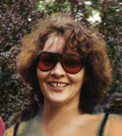
The Cornell Electron Storage Ring (CESR) collides beams of electrons and positrons (anti-electrons). When collisions occur, new particles are produced, and the CLEO particle detector observes them. Together, CESR and CLEO have revealed the important properties of the bottom and charm quarks and the tau lepton. Now, with the CLEO-c program, they are delving further into the mysteries of the charm quark, making measurements that are critical for understanding the strong force, which binds protons and neutrons and governs quark behavior. In parallel, LEPP theorists are developing new techniques for calculating strong force phenomena. Some apply the power of computers to the strong force using so-called lattice gauge theory techniques, while others seek patterns that relate disparate strong interaction processes. You can learn more about CESR and CLEO and their science by taking a virtual tour of Wilson Laboratory, the Cornell lab where they are sited.
In addition to its role in particle physics, CESR is an intense source of x-rays. The Cornell High Energy Synchrotron Source (CHESS) provides these x-rays to scientists, from surface physicists to medical biologists, allowing them to study the microscopic structure of materials.
In 2007, the Large Hadron Collider (LHC), which is sited at the CERN Laboratory in Geneva, Switzerland, will begin colliding beams of protons with an energy far beyond the energy of any previous accelerator. For the first time, we will glimpse the physics that lies at the TeV (pronounced "T" "E" "V") energy-scale. Physicists believe that TeV energies hold the answer to why electromagnetism is so powerful compared with its unification partner, the weak force. There are hints that the TeV energy scale will also reveal broad new vistas of physics -- perhaps new forms of matter or forces that we have never seen before. LEPP physicists are contributing to the Compact Muon Solenoid (CMS) detector, one of two enormous detectors that will view the collisions at the LHC. They are also engaged in exploring this physics theoretically.
| I | Attachment | Action | Size | Date | Who | Comment |
|---|---|---|---|---|---|---|
| |
jcb_mug.jpg | manage | 58 K | 21 Dec 2006 - 08:11 | UnknownUser | |
| |
mugshot.gif | manage | 16 K | 08 Jan 2007 - 21:45 | DevinBougie |
Topic revision: 16 Feb 2007, JeanneButler
 Copyright © by the contributing authors. All material on this collaboration platform is the property of the contributing authors.
Copyright © by the contributing authors. All material on this collaboration platform is the property of the contributing authors. Ideas, requests, problems regarding CLASSE Wiki? Send feedback